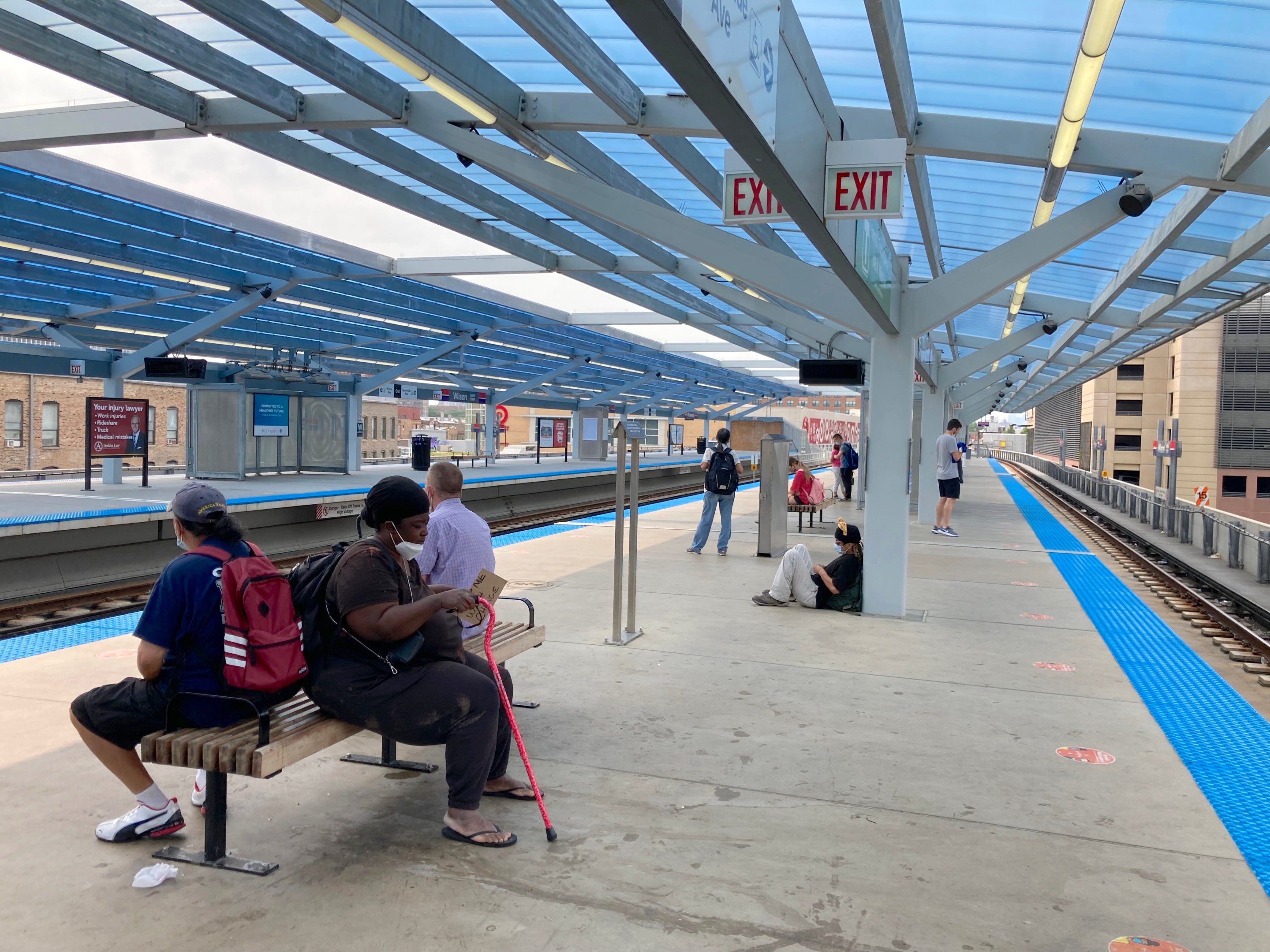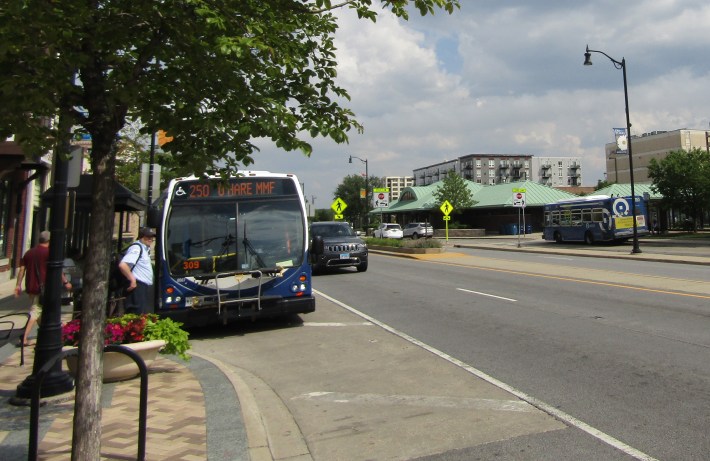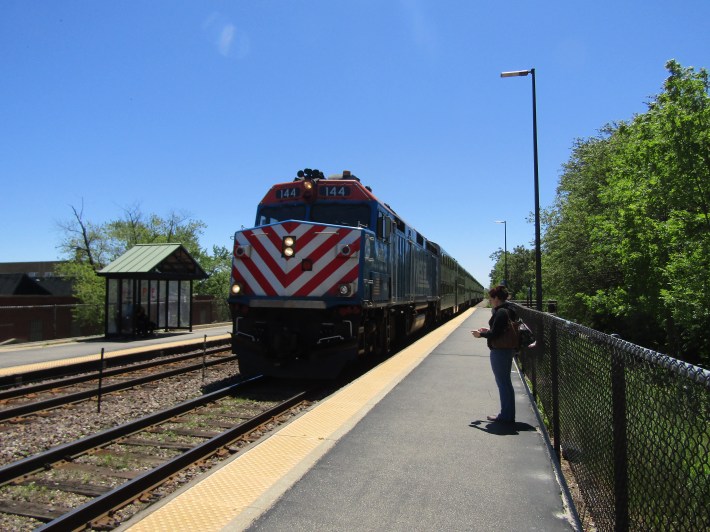RTA’s new capital funding formula prioritizes existing assets, speed over innovation
3:37 PM CDT on July 23, 2021

The Wilson Red Line platform. Photo: John Greenfield
The Regional Transit Authority board unanimously approved a new formula for splitting capital funding between the CTA, Metra and Pace, putting emphasis on fixing and upgrading their existing assets and funding projects that promote equity, while leaving less money for service expansion and building new assets.
When RTA released its funding plan on June 17, the transit agencies, as well as a number of Chicago area elected officials and civic organizations, argued that the new allocations don’t give the agencies enough money to innovate, and that the definitions of equity were too vague. They urged the RTA to delay adopting the guidelines to allow for more discussions and public input.
But during its July 15 meeting, the RTA Board of Directors approved the framework anyway. The staff explained that the federal and state grant deadlines left them with little choice – if they didn’t approve the formula at the time, they wouldn’t be able to use the money for another year. The directors and staff said several times that they would try to address the aforementioned concerns during the budget process for the RTA and the three agencies it oversees, which will take place throughout the fall of 2021.
The New Formula
The capital allocation formula specifically deals with funds from the Rebuild Illinois capital bill and federal grants. It doesn’t include the funds from the most recent stimulus package – as we’ve reported before, RTA plans to figure out how to divide that up as part of the budget process.
While the money will be divided among similar proportions as before – 59.7 percent of the funding will go to the CTA, 32.8 percent will go to Metra and 7.5 percent will go to Pace – the new formula creates two major changes. Half of the funds will have to be spent on replacing vehicles, fixing infrastructure, and otherwise bringing assets into a "state of good repair" within the next 20 years.
The other half of the cash will be available for all capital projects, with one caveat. Each agency has a 5-year capital plan. If an agency spends at least half of the capital funding within 2.5 years and at least 20 percent of the funds during each given year, it will get the entire half of its share of the funding. But if an agency doesn’t spent the funds quickly enough, the allocation will be reduced, with the money the agency would normally get going into a discretionary fund. RTA plans to figure out the formula for how discretionary funds would be spent later this year. To avoid drastic drops in funding, the penalty would be no more than 20 percent of what the agency would normally get from both halves.
Finally, at least 20 percent of all capital funding must be spent on improving equity and accessibility. The former is defined as “projects [that] would improve access to transit and access to opportunities across the large and diverse RTA region.”
In response, the CTA, Metra and Pace raised concerns that RTA’s state of good repair information was outdated. They asked the RTA to figure out how discretionary funds would be spent and clarify which projects would count as racially equitable and accessible.

In a letter to the RTA, Pace asked the RTA to hold off on adopting the formula because, with the pandemic still ongoing, “we still don’t know what a new normal will look like. The proposed capital metrics focus solely on the state of good repair and do not factor future growth and new market opportunities. Pace proposes incorporating population into the calculation for the RTA's consideration.”
Pace’s proposed long-range plan calls for an extensive study of service markets throughout the Chicago area, which could mean significant service changes.
Stakeholder Concerns
Other letters to the RTA expressed concerns that RTA’s emphasis on state of good repair was stifling innovation, and argued that equity and accessibility should be more clearly defined to ensure consistency, and that some money should be allocated for joint projects between agencies.
A July 1 joint letter from 13 civic organizations, including the Active Transportation Alliance, the Metropolitan Planning Council, the Illinois chapter of the Sierra Club, and the Chicagoland Chamber of Commerce argued that the emphasis on spending money quickly would disincentivize long-term projects that could benefit the region in the long run.
Cook County president Toni Preckwinkle sent a letter urging the RTA to raise the equity and accessibility targets. She also asked the RTA and the three agencies to create seamless transfers between Metra, the CTA, and Pace, something that has long been stymied by the fact that Metra uses a zone-based system.

The Metropolitan Mayors Caucus, a coalition of Chicago area regional councils, argued in a letter to RTA that the formula doesn’t do a good job incentivizing regional projects “The RTA’s recent draft funding reform proposal lacks true performance measures that can help drive investment toward regional goals of equity, access, and economic growth,” the letter stated. “The draft proposal also misses an opportunity to leverage partnerships with local communities and other funding partners to advance regionally significant transit projects that cross municipal boundaries, require enhanced coordination among the transit agencies, and are difficult to fund under the current formula structure.”
RTA Board Vote
The July 15 meeting was a hybrid in-person / online meeting that was plagued by audio issues, especially when it came to comments from directors and staff members who attended in person. But based on what I did hear, the directors said that, while they appreciated the aforementioned concerns, making sure the money is available as soon as possible took priority.
Jill Leary, the RTA’s head of capital programming, said that the RTA “will provide additional guidance to service boards about the definitions of equity in the budget process to ensure that the progress will meet the three [formula] requirements... We acknowledged that what we built and developed here is not perfect, but allows us to take a step or two forward."
Director Christopher Melvin, who represents Chicago, argued that the letters downplayed the importance of the state of good repair. “Think of it in three ways. There is user experience, which is important. It's important to have good, comfortable buses and trains, to have safe, well-lit stations. Secondly, on operating basis, if you got modern equipment, you have to spend less money on repair, so it's more efficient use of taxpayer dollars, Third, we're all concerned about people moving out of the region, moving out of state. We're clearly in competition with other regions, and our transposition system is a gem of the region, and it's incumbent of us to maintain it,'”
Director Mary Beth Canty, who represents suburban Cook County, said that stakeholder concerns were “important observations” and that “there some requests that I think should be taken seriously. Btu what I don't want to see is perfect get in the way of progress.”
“Everybody will be at the table,” promised director Michael Lewis, who also represents suburban Cook County “Nothing is locked in stone, except maybe Ten Commandments, so this not the end of everything today.”
In a follow-up interview, Audrey Wennink, said that while state of good repair was important, the organizations still feels that the RTA’s emphasis on fix-it-first would lead to “rebuilding old systems that need to be reevaluated.” She said that she hopes that the RTA will follow through on addressing their concerns.
“Advocates will continue to engage with the RTA and its board members on an ongoing basis to ensure that venues for stakeholder engagement are offered and that the capital allocation methodology continues to evolve and incorporates some of our suggestions,” Wennink said. “The RTA has committed to writing a formal response to advocates and we hope they will make some firm commitments in this regard.”
Stay in touch
Sign up for our free newsletter
More from Streetsblog Chicago
The de-facto ban on riverwalk biking is back. What should we do about it?
In the short term, new signage is needed to designate legal areas for cycling on the path. In the long term CDOT should build the proposed Wacker Drive protected bike lane.
Today’s Headlines for Thursday, April 25
It’s electric! New Divvy stations will be able to charge docked e-bikes, scooters when they’re connected to the power grid
The new stations are supposed to be easier to use and more environmentally friendly than old-school stations.



